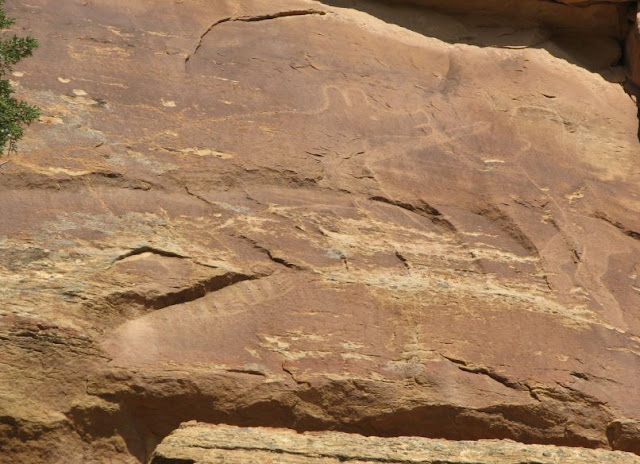Jensen, Utah
We have thoroughly enjoyed our time in Jensen, starting with the park we tried, Outlaw Trail RV Park. It is not fancy, but has the things we really appreciate:- Very friendly and kind owner Monica
- Great low price
- RV park is not crowded but has campers coming in and out during the week
- Full hookup including sewer
- Very quiet out in a rural setting
- Nice mountain views right from the park and our trailer
- Gravel and paved roads, no bare ground or dirt - that keeps the dust down and mud away when it rains.
- Natural attractions in the area.
- Temperate weather
 The really big story on this post are the petroglyphs and pictographs we observed in this area. We found these in several places, some public lands, some private land. The first excursion was down a dirt road into a northern part of the Dinosaur National Monument along Brush Creek. There were a few bad spots in the road, but for the most part it was a well maintained dirt & gravel road.
The really big story on this post are the petroglyphs and pictographs we observed in this area. We found these in several places, some public lands, some private land. The first excursion was down a dirt road into a northern part of the Dinosaur National Monument along Brush Creek. There were a few bad spots in the road, but for the most part it was a well maintained dirt & gravel road.This area was formed by tremendous geological forces at the same time the Rocky Mountains began to rise. The mountain-building at Dinosaur, did not simply push up the rock layers from below, but also squeezed them from the sides, warping and lifting them, sometimes cracking and shifting them along fault lines producing the dramatic effects we see today.
Soon we came to the petroglyphs near the end of the road. We see the first one up high in the rocks and it is Big and of a person! All of the petroglyphs we observed in this area were left by the Fremont people who lived in and around this area of north eastern Utah from approximately 200 A.D. to 1300 A.D.
Steve goes in for a closer look at this grouping high up on a rock.
The guy with the bushy mustache reminded Steve of the Door Guard at the Emerald City in The Wizard of Oz. Not a whole lot is known about the purposes of these rock drawings, but we looked upon these things with awe.
Gari stands next to the first petroglyph we saw, which appears to be a female figure. The black coloring on the rock face is called desert varnish, or desert patina. It forms by clay and other trace elements blowing in the wind and adhering to the rock face then these materials are oxidized by the air and sun. The artists then simply chip away the black varnish to reveal the petroglyph outlines.
Steve ponders a busy panel.
You can see very well where this figure's body was completely chiseled out.
Gari delights at another busy panel.
This is Mountain Lion country and Gari has her bear spray ready in hand while we are way up in the rocks!
A parting shot from the road on the way back out Brush Creek. It looks like a Buffalo is in that panel. A hunting trip perhaps?
Next outting, different day, at the Red Cloud Loop north west of Vernal, Utah. This was a drive that went way up into the Utah mountains and we proceeded around a 40 mile Forest Service dirt road loop. We mainly saw beautiful environment and geologic features until we reached the McConkie Ranch... then we saw more petroglyphs.
We finally reached just under 10,000 Ft. You can see 12,000 ft Taylor Mountain in the distance below. There were several campers set up along this loop. We don't think we would attempt to pull our rig way up here. We are too big and heavy and low to the ground for that.
We saw lots of Aspen trees way up there, many were already turning gold.
From the overlook below it is clear where the Aspen trees are growing.
Coming down the mountain we began to see some majestic rock walls.
That spire rock formation is known as a Hoodoo. Really.
Jagged rocks.
Sheer cliff walls.
A notch in the rocks.
Interesting formation.
Then we finally came upon the McConkie Ranch. It was nestled up against the cliff wall.
This way, Gari is in the lead.
Up the steep trail Gari goes. We weren't worried about lions here, but did watch carefully for Mr. No-Legs, aka SNAKE.
We see two petroglyphs with pictograph pigment way up high.
Zoom in for a better look.... early astronauts? ...and a little guy on the side.
It's pretty up here in the rocks.
What a pretty view!
Gari in front of a few strange designs up high... disconnected head and feet.
Gari found a little deer?
It's OK this Mr. has legs.
Steve below an entire family perhaps.
A spiral with pigment... and something else going on the the lower right
The Headhunters.
Ahhh... this is the bear and brave panel, can you see them? They are hard to see.
The twins.
We have one more post coming from Jensen - Vernal area, then on to Moab, Utah we go.











































































